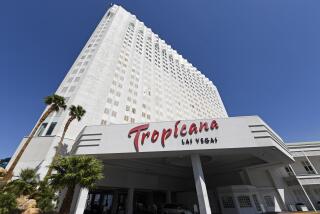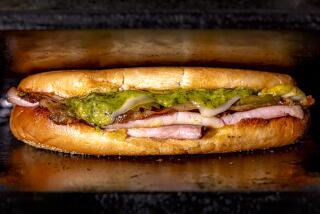Las Vegas embraces its mobster past
Las Vegas, a city forged on gambling, booze and flesh, has been strangely reluctant -- and perhaps a little nervous -- to make money off its mob roots. Until now.
On a recent drizzly night, a small, white Vegas Mob Tour bus rumbled past aging strip malls, its passengers eager to see the spots where wiseguys were killed.
Thug Jerry Lisner was repeatedly shot, strangled with an electrical cord and dumped in his swimming pool on a tree-lined street named Rawhide. Tour guide Robert Baltus pointed out the street but not the house -- the owners are uneasy about publicizing its bloody past.
In a Tony Roma’s parking space next to a light pole, Frank “Lefty” Rosenthal was nearly blown up in his booby-trapped Cadillac Eldorado. “He should have been in 50 different pieces,” Baltus told a dozen silent tourists, but a steel plate under the car saved the casino executive’s life.
Paul Johnson, 56, was transfixed as the bus whizzed past a pizza parlor, church and hotel that at one time were linked to the mob. An industrial electrical contractor from Dickinson, N.D., Johnson said he had run across mobsters during his oil industry days. But he wasn’t spilling anything about his brush with organized crime. Not in this city.
“Vegas was built with mob money,” he said. “They did a hell of a job.”
Americans have long been entranced by hooligans who laundered money, bootlegged, bullied and killed. Entrepreneurs have bused tourists to mob haunts in Newark, N.J.; Kansas City, Mo.; and Chicago. Vegas’ own godfathers were immortalized in the 1995 Martin Scorsese movie “Casino,” which was partly filmed here.
Sin City has dusted off its gangster skeletons with the Vegas Mob Tour based at the Greek Isles Hotel & Casino, “Sopranos”-inspired dinner theater at the Riviera Hotel & Casino and a proposed mob museum.
The tour offers insight into how this city has -- mostly -- made peace with gangsters such as Tony “the Ant” Spilotro and mob bosses who helped turn the remote town into a resort by investing in casinos that mainstream businessmen scorned.
The tour devotes time to Frank “King Rat” Cullotta, the hitman-turned-informant who killed Lisner, a low-level criminal whom Spilotro feared was a turncoat. Baltus said Cullotta -- who’s still alive -- told him that after the slaying he drove to a pizza restaurant for a snack.
You can learn more, Baltus tells passengers, by buying “Cullotta” the book or “Cullotta” the DVD -- both available at Greek Isles.
The latest mob enterprises are possible because of the Vegas ingenuity that has milked cash even from the atomic bomb, and the long passage of time since underworld types ruled the Strip. The last element, said mob tour founder Robert Allen, a native Chicagoan, might be most essential.
“I can only do this tour,” he said, “because Tony Spilotro’s dead.”
Two years ago, Allen put down the morning paper, inspired.
The Las Vegas Review-Journal had pieced together a “wise guide”: a map that included the Tony Roma’s, Benjamin “Bugsy” Siegel’s Flamingo Hotel, and the unusual spot where a thug named Herbert “Fat Herbie” Blitzstein was killed: his home. This, the paper said, defied an axiom of the city’s gangster era: No one is killed in Vegas; they’re driven to the desert first.
Why, Allen wondered, wasn’t anyone in town making money off mob stories?
There was the dashing Siegel, who opened the Flamingo months before he was gunned down in Beverly Hills in 1947 -- possibly at the behest of another underworld figure, Meyer Lansky. In the 1970s, Lansky and others were charged with skimming tens of millions from the Flamingo, but a judge ruled he was too ill to stand trial.
Spilotro was a suspect in dozens of killings, according to the book “Of Rats and Men” by local columnist John L. Smith. Spilotro and his gang were charged in connection with a gift shop burglary, but before the case could be retried, Spilotro and his brother were killed and buried in an Indiana cornfield in 1986.
“Maybe people were afraid to tell their stories before,” Allen said.
So Allen -- a comedian who had performed at the ostensibly mob-financed (and since-imploded) Dunes Hotel -- linked up with Denny Griffin, a former healthcare fraud investigator who has written several books about Vegas mobsters. Watching older casinos tumble like dominoes to make way for mega-resorts, Griffin fretted that Las Vegas was throwing away its history, particularly the organized-crime chapter.
“The mobsters weren’t founding fathers in the sense of George Washington, but they served an equally important role here,” Griffin said.
Griffin made sure the tour’s hoodlum highlights tracked with his research. Allen sketched out a script and hired guides such as Baltus to deliver it with streetwise swagger. The tour’s sights aren’t spectacular -- the bus often idles in parking lots -- but the stories are.
“I try to do it tactfully and with taste, as much as you can with a mob tour,” Allen said. “You can say someone cut off someone’s head with a machete, but we prefer to say decapitated.”
He apparently tapped into something. About the same time, “The Soprano’s Last Supper,” now running at the Riviera, opened. It’s set at a going-away party for just-indicted crime boss Tony Soprano, who’s hiding in Vegas as Tony Baritone. (Cue laughter.)
The dinnertime musical -- with pasta, naturally, as the main dish -- has done well enough that its producer is in talks to run sightseeing tours to the Grand Canyon with comedic mobster characters behind the wheel.
City officials are pushing forward with a multimillion-dollar mob museum slated for a brick building downtown, where in 1950 a congressional committee grilled a Flamingo executive about his links to Siegel and Lansky.
The proposed museum has raked in plenty of attention. Some old-timers reminisce about how gangster-run Vegas was cheaper, cleaner, safer and smaller. But scoldings have poured in from as far away as Michigan. “It’s bad enough to be called ‘Sin City,’ ” the Oakland Press editorialized, “but a museum to mobsters?”
The mob was a force in Las Vegas until the mid-1980s, when law enforcement pressure and the corporate takeover of casinos loosened the gangsters’ grip. Las Vegas can’t wipe away its past, said Michael Green, a College of Southern Nevada history professor and mob museum consultant, so it’s coping the only way it knows how.
“The mentality is, ‘You know what? [Outsiders are] never going to accept us. So let’s get rich from them,’ ” Green said.
Museum backers are haggling over the same things Allen did: How do you tell stories about gangsters without lionizing -- or demonizing -- them?
It’s tricky. But mobsters’ relatives who have taken the tour, Allen said, thanked the guides for treating the men’s legacies with respect.
“There’s been a few nights when I’m like, uh, should we be doing this?” he said. “But I think we’ve got the tone right: Even if he’s a mobster, you still don’t speak badly of the dead.”
Aboard the tour bus, Baltus, a bespectacled man in suspenders and pinstriped pants, launched into a tutorial unfit for grade-schoolers.
The mob is a web of made men, he said.
A made guy knows enough about dirty dealings “to get himself buried.”
Also, “you’ve got to be 100% Sicilian and clip, whack or kill someone.”
Clip and whack, he explained, are synonyms for kill.
Got it?
Charles Feris nodded. The retired meteorologist from Portland, Ore., had watched “Casino” to prepare for the 2 1/2 -hour, $56.25 tour. An Italian who grew up in Chicago, Feris remembers hanging out in gangster-run bars and strip joints.
“We had friends of friends who were connected,” said Feris, 70, so he was eager to check out the Mafioso hangouts. “Vegas just seems to be getting in touch with [its] mob past. Who knows, maybe they’ll build a themed mob hotel someday.”
The bus rumbled east of the Strip, dark inside save a small screen that blinked black-and-white photos. Baltus ran through the spiel -- a mob buff’s take on history and culture -- in an accent that turned his hometown into “Chi-caw-go.”
The Kennedy assassination: “The Outfit put him in; the Outfit took him out.”
The movie “Casino”: “100% true.”
The bus halted next to a restaurant named Piero’s, whose website describes its onetime clientele as “some of those businessmen in the casino industry with Italian surnames.” It was a hangout for Spilotro, who terrified folks with his stare, Baltus said. When Spilotro trained it on foes, they eventually got whacked. With waitresses, he just wanted coffee.
As the bus pulled away, Baltus told the out-of-towners about Rosenthal; Robert De Niro played a character based on the Stardust manager in “Casino.” At the Stardust, gangsters purportedly packed cash into suitcases -- in part to avoid paying taxes -- and flew it to mob bosses in Chicago and Kansas City.
“Does everybody know what a skim operation is?” Baltus asked.
“Yes!” someone replied.
About a dozen mob haunts later, the bus came to its last stop: the Flamingo, where the pink neon “F” had fizzled out. The tourists filed into the chilly night as Baltus spun the tale of Siegel, whom Warren Beatty portrayed in the 1991 movie “Bugsy.” His hotel’s construction costs soared over budget, but his vision was prescient -- the Flamingo was intended as a luxury getaway for Siegel’s neighbors, the Los Angeles elite; decades later, Vegas touts itself as an upscale playground.
Siegel “probably would have been the godfather of Las Vegas if he had been here,” Baltus said.
The group shuffled past the occasional flamingo lawn ornament to stop at a mounted plaque dedicated to Siegel. Baltus told the sightseers that Siegel had getaway tunnels dug under the hotel.
When the tourists climbed back onto the bus, the video screen said, “Warning: The Next Photo May Upset Some Viewers.” They tittered in anticipation. Baltus flashed a photo of Siegel caked in blood, an eye blown out in a grisly demise.
No one winced.
More to Read
Sign up for The Wild
We’ll help you find the best places to hike, bike and run, as well as the perfect silent spots for meditation and yoga.
You may occasionally receive promotional content from the Los Angeles Times.






